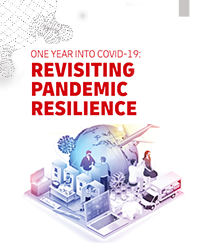Grow your business with the Discover newsletter
Logistics advice & insights straight to your inbox
Subscribe now
The COVID-19 outbreak has been one of the biggest public health emergencies the world has seen in 100 years. The disruptions it has caused have not only affected the air cargo sector but every aspect of society and businesses at large. In fact, governments of many countries are running against time to vaccinate their citizens so that day-to-day activities can return to a state of normal functioning. And as of May 2021, Israel is one of the first countries to have vaccinated majority of its population.
As the world attempts to move beyond the multiple waves of the epidemic, countries are looking forward to opening international borders as well. This will help the global economy to resuscitate. And a way of doing that is to make sure all nations are able to meet the demand for the required number of vaccine doses for their citizens since vaccinated populations can break the chain and travel without COVID-19 related restrictions.
In that light, IATA states that “accepting vaccinated passengers should be the best practise to reopen borders. In cases where vaccination is not possible, access to quarantine-free travel should be provided through COVID-19 testing strategies based on widely available, free-of-charge tests.” Germany is one such country that has alleviated quarantine requirements for vaccinated travellers. This is an indicator that while we are not at the finish line yet, countries are working hard towards achieving normalcy.
It’s already been one year into the COVID-19 pandemic and it has taught many countries across the globe many great lessons. To understand this, DHL Express has released a whitepaper, titled, “Revisiting Pandemic Resilience”, in which it has explained what those learnings are in depth.
2020 was a tough year that brought with itself indomitable challenges. Despite that, we have been able to learn and understand the importance of research and development as well as production and supply chain management. Acting in line with these lessons will help us overcome this humanitarian crisis, and be prepared for any public health emergency that might hit us in the future.
Here is what the DHL Express whitepaper, “Revisiting Pandemic Resilience” has observed:
Good logistics and supply chain management have ensured the availability and dispersion of medicines and medical supplies, such as treatments, vaccines, ancillary stocks, test kits, and personal protective equipment in this pandemic.
DHL Express, a trusted partner for COVID-19 vaccine logistics, has distributed over 200 million doses of all approved vaccines across over 120 countries. Our in-house team of international specialists carries in-depth experience in handling medical shipments and clearing them off customs duties. Not only that, our Medical Express (WMX) service is extremely patient-centric and transports all medical and pharmaceutical products under controlled temperatures with a door-to-door visibility.
With more than 350 DHL facilities and over 9,000 flights deployed to deliver the vaccines worldwide, DHL Express helps in maintaining the efficacy of the supply chain through speed, safety and real-time traceability. Even now, DHL Express continues to serve multiple lanes out of Europe and other places of origin for transporting COVID-19 vaccines.
The recently published DHL whitepaper on “Revisiting Pandemic Resilience” provides comprehensive insights into what the logistics sector has learned from this race against COVID-19 how they can build a reliable supply chain to handle public health crises in the future.
If you are curious to know more about our services and involvements towards global vaccine distribution, read more about it!
One Year Into COVID-19 Revisiting Pandemic Resilience; Download the Whitepaper here

